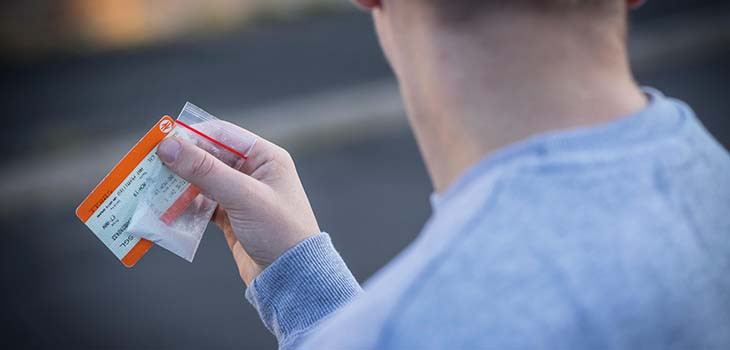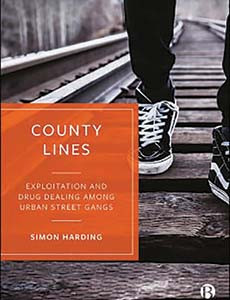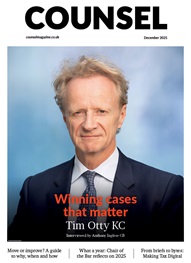*/

I first met Dr Simon Harding at a recent trial at Wood Green Crown Court, where he was a defence expert for a defendant facing a serious drug conspiracy charge. Dr Harding is a Professor of Criminology at the University of West London and has dedicated the last 20 years to researching and writing on gang culture. In particular, he has focused on the County Lines phenomenon, also the subject of his book published last year.
Section 45 of the Modern Slavery Act 2015 created an absolute defence for a defendant charged with the most serious crimes, provided that they can demonstrate tHat they were compelled to commit the crime due to exploitation. Those wishing to run such a defence usually go through the National Referral Mechanism (NRM) where the Single Competent Authority (SCA) makes a decision as to whether that individual is a victim of modern slavery. It is a two-stage process: first, it must be determined that there are reasonable grounds to assume the defendant might be a victim; and second is a deeper evaluation of whether there are conclusive grounds that the defendant is a victim of modern slavery.
Following a positive grounds decision, the Crown will review the case. However, they may still believe it to be in the public interest to proceed. At that point, the burden of deciding whether the defendant is a modern slave and therefore entitled to the defence, falls on the jury.
The case of Brecani (R v Brecani [2021] EWCA Crim 731) has complicated matters for defence lawyers. The Court of Appeal held that NRM evidence that the defendant is a victim of modern slavery is not admissible in a criminal trial because the decision-maker is a civil servant and not an expert.
Enter Dr Simon Harding, modern slavery expert. After the standard technical Zoom issues, the two of us settle down to a chat in the first week of January.
Dr Harding describes the evolution of the UK’s illegal drugs market to me: ‘The markets used to be very localised and you would have a recognised dealer. Now what we see are organised criminal gangs from metropolitan areas who take the drugs directly from wholesale down to the end user in rural or seaside towns. They often exploit young people by asking them to transport the drugs on public transport, as they are less likely to be suspected by the police.’
The sale of drugs in each area is organised through a drug line. The burner phone carrying the line is hugely valuable to the gangs as it can hold a database of 200-300 customers. Dr Harding emphasises the highly sophisticated nature of County Lines and the huge prize at the end: a single drug line can earn £500,000 or more in profit for the gangs. The National Crime Agency (NCA) estimates that as many as 2,000 lines are in operation. Each line will consist of one or two managers and perhaps 10 young people.
So how does a young person get recruited into the gang? ‘It is a long-term grooming process which often starts at the school gates and the young people are often tempted by the prospect of an exciting or glamorous lifestyle and lots of money,’ Dr Harding tells me. ‘It is no longer London centric; the development of county lines means that young people in small towns, often traditionally middle-class areas, are being recruited too.’
The often-heard trope is that gangs offer young people, perhaps with difficult home lives, a sense of community and belonging. Dr Harding, however, believes that this angle can be overstated. ‘The gangs do offer companionship and excitement, an opportunity to get out the house and go somewhere new and exciting.’ However, having spent hours in the trap houses interviewing gang members for his book, he assures me that this ‘glamour’ soon wears off after living through a week in a trap house, surrounded by intravenous drug users, sleeping on bare floorboards hundreds of miles from home. ‘Once they are drawn in, the debt that they owe to the gang escalates.’
To maintain profits and avoid authorities, the drugs line must be tightly controlled. The individuals working in the line may be subject to surveillance or so-called ‘remote mothering’ such as hourly check-ins. A perceived infringement of the rules – such as lateness, skimming money off the profits or bringing the gang to the attention of the police – results in punishments. Dr Harding describes violence in the gangs as ‘ever present’, with threats often targeted at gang members’ family members.
One aspect of servitude to the gangs and method of control, which often rears its ugly head in criminal trials, is debt bondage. Dr Harding describes a technique used by the gang to trick the young person into the debt: ‘It is very “snakey” and manipulative. It is a way of engendering a debt that doesn’t exist. The gang asks the young person to hold some drugs and then arranges for a fake robbery, so the individual has been robbed both of the drugs and the potential profit from selling the drugs, a double debt which escalates very quickly through interest.’ A single drug line can earn £500,000 or more per year.
To demonstrate remorse, the targeted individual is subject to the control of the managers and forced to pay off the debt, which increases daily with interest and can never be completely paid off. That individual often works for little or no profit and is given the riskiest tasks as he or she is considered as dispensable. Debt bondage is described as widespread and common by the NCA.
Dr Harding tells me about a case he worked on recently where the parents were forced to pay the debt to extract their child from the bondage. ‘This can range from £1,000 to as much as £70,000. The violence of gang life is now reverberating back to the families, who receive videos of their son or daughter restrained in the boot of the car alongside a demand for money. While ruthless, this is unsurprisingly a very effective technique for generating money. Months later, the same young person could end up being drawn into a different drug line and the cycle begins again.’
While a demonstration that the defendant is a victim of modern slavery provides a complete defence, sometimes the court or juries are sceptical as to whether that individual is a genuine victim or has simply been coached to say that they are, should they be caught. I ask Dr Harding whether, in his experience, this happens: ‘It is very difficult to tell. I know that coaching does take place. When a property is raided and an individual is arrested and that individual is found with lots of drugs and cash, they are thought to be an active drug dealer, doing so with enthusiasm and for profit. However, behind the scenes they can still be vulnerable and exploited. I am finding in almost every case that the victims have neurodiversity issues – ADHD, autism, dyspraxia, dyslexia and learning difficulties. Our understanding of criminal exploitation is still new and developing, it used to be that modern slavery was women being trafficked from Romania, now we understand that it is much wider than that.’
Dr Harding believes that the criminal justice system is ‘late to the game’ when it comes to understanding exploitation and modern slavery. Training would help to develop understanding. However, this area is enormously underfunded with no research money available.
What is clear is that Brecani has made it much more challenging for the defence to demonstrate that the defendant is exploited and under duress to commit the crime. However, experts such as Dr Harding are an invaluable tool in the arsenal to explore these issues at trial.

County Lines: Exploitation and Drug Dealing among Urban Street Gangs by Simon Harding (Bristol University Press: 2020). Exploring how county lines evolve, Harding reveals extensive criminal exploitation and control in the daily ‘grind’ to sell drugs. Drawing upon extensive interviews and case studies, this book gives voice to users and dealers, providing an in-depth analysis of techniques, relationships and ‘trapping’.

I first met Dr Simon Harding at a recent trial at Wood Green Crown Court, where he was a defence expert for a defendant facing a serious drug conspiracy charge. Dr Harding is a Professor of Criminology at the University of West London and has dedicated the last 20 years to researching and writing on gang culture. In particular, he has focused on the County Lines phenomenon, also the subject of his book published last year.
Section 45 of the Modern Slavery Act 2015 created an absolute defence for a defendant charged with the most serious crimes, provided that they can demonstrate tHat they were compelled to commit the crime due to exploitation. Those wishing to run such a defence usually go through the National Referral Mechanism (NRM) where the Single Competent Authority (SCA) makes a decision as to whether that individual is a victim of modern slavery. It is a two-stage process: first, it must be determined that there are reasonable grounds to assume the defendant might be a victim; and second is a deeper evaluation of whether there are conclusive grounds that the defendant is a victim of modern slavery.
Following a positive grounds decision, the Crown will review the case. However, they may still believe it to be in the public interest to proceed. At that point, the burden of deciding whether the defendant is a modern slave and therefore entitled to the defence, falls on the jury.
The case of Brecani (R v Brecani [2021] EWCA Crim 731) has complicated matters for defence lawyers. The Court of Appeal held that NRM evidence that the defendant is a victim of modern slavery is not admissible in a criminal trial because the decision-maker is a civil servant and not an expert.
Enter Dr Simon Harding, modern slavery expert. After the standard technical Zoom issues, the two of us settle down to a chat in the first week of January.
Dr Harding describes the evolution of the UK’s illegal drugs market to me: ‘The markets used to be very localised and you would have a recognised dealer. Now what we see are organised criminal gangs from metropolitan areas who take the drugs directly from wholesale down to the end user in rural or seaside towns. They often exploit young people by asking them to transport the drugs on public transport, as they are less likely to be suspected by the police.’
The sale of drugs in each area is organised through a drug line. The burner phone carrying the line is hugely valuable to the gangs as it can hold a database of 200-300 customers. Dr Harding emphasises the highly sophisticated nature of County Lines and the huge prize at the end: a single drug line can earn £500,000 or more in profit for the gangs. The National Crime Agency (NCA) estimates that as many as 2,000 lines are in operation. Each line will consist of one or two managers and perhaps 10 young people.
So how does a young person get recruited into the gang? ‘It is a long-term grooming process which often starts at the school gates and the young people are often tempted by the prospect of an exciting or glamorous lifestyle and lots of money,’ Dr Harding tells me. ‘It is no longer London centric; the development of county lines means that young people in small towns, often traditionally middle-class areas, are being recruited too.’
The often-heard trope is that gangs offer young people, perhaps with difficult home lives, a sense of community and belonging. Dr Harding, however, believes that this angle can be overstated. ‘The gangs do offer companionship and excitement, an opportunity to get out the house and go somewhere new and exciting.’ However, having spent hours in the trap houses interviewing gang members for his book, he assures me that this ‘glamour’ soon wears off after living through a week in a trap house, surrounded by intravenous drug users, sleeping on bare floorboards hundreds of miles from home. ‘Once they are drawn in, the debt that they owe to the gang escalates.’
To maintain profits and avoid authorities, the drugs line must be tightly controlled. The individuals working in the line may be subject to surveillance or so-called ‘remote mothering’ such as hourly check-ins. A perceived infringement of the rules – such as lateness, skimming money off the profits or bringing the gang to the attention of the police – results in punishments. Dr Harding describes violence in the gangs as ‘ever present’, with threats often targeted at gang members’ family members.
One aspect of servitude to the gangs and method of control, which often rears its ugly head in criminal trials, is debt bondage. Dr Harding describes a technique used by the gang to trick the young person into the debt: ‘It is very “snakey” and manipulative. It is a way of engendering a debt that doesn’t exist. The gang asks the young person to hold some drugs and then arranges for a fake robbery, so the individual has been robbed both of the drugs and the potential profit from selling the drugs, a double debt which escalates very quickly through interest.’ A single drug line can earn £500,000 or more per year.
To demonstrate remorse, the targeted individual is subject to the control of the managers and forced to pay off the debt, which increases daily with interest and can never be completely paid off. That individual often works for little or no profit and is given the riskiest tasks as he or she is considered as dispensable. Debt bondage is described as widespread and common by the NCA.
Dr Harding tells me about a case he worked on recently where the parents were forced to pay the debt to extract their child from the bondage. ‘This can range from £1,000 to as much as £70,000. The violence of gang life is now reverberating back to the families, who receive videos of their son or daughter restrained in the boot of the car alongside a demand for money. While ruthless, this is unsurprisingly a very effective technique for generating money. Months later, the same young person could end up being drawn into a different drug line and the cycle begins again.’
While a demonstration that the defendant is a victim of modern slavery provides a complete defence, sometimes the court or juries are sceptical as to whether that individual is a genuine victim or has simply been coached to say that they are, should they be caught. I ask Dr Harding whether, in his experience, this happens: ‘It is very difficult to tell. I know that coaching does take place. When a property is raided and an individual is arrested and that individual is found with lots of drugs and cash, they are thought to be an active drug dealer, doing so with enthusiasm and for profit. However, behind the scenes they can still be vulnerable and exploited. I am finding in almost every case that the victims have neurodiversity issues – ADHD, autism, dyspraxia, dyslexia and learning difficulties. Our understanding of criminal exploitation is still new and developing, it used to be that modern slavery was women being trafficked from Romania, now we understand that it is much wider than that.’
Dr Harding believes that the criminal justice system is ‘late to the game’ when it comes to understanding exploitation and modern slavery. Training would help to develop understanding. However, this area is enormously underfunded with no research money available.
What is clear is that Brecani has made it much more challenging for the defence to demonstrate that the defendant is exploited and under duress to commit the crime. However, experts such as Dr Harding are an invaluable tool in the arsenal to explore these issues at trial.

County Lines: Exploitation and Drug Dealing among Urban Street Gangs by Simon Harding (Bristol University Press: 2020). Exploring how county lines evolve, Harding reveals extensive criminal exploitation and control in the daily ‘grind’ to sell drugs. Drawing upon extensive interviews and case studies, this book gives voice to users and dealers, providing an in-depth analysis of techniques, relationships and ‘trapping’.


Chair of the Bar reflects on 2025
AlphaBiolabs has donated £500 to The Christie Charity through its Giving Back initiative, helping to support cancer care, treatment and research across Greater Manchester, Cheshire and further afield
Q&A with criminal barrister Nick Murphy, who moved to New Park Court Chambers on the North Eastern Circuit in search of a better work-life balance
Revolt Cycling in Holborn, London’s first sustainable fitness studio, invites barristers to join the revolution – turning pedal power into clean energy
Rachel Davenport, Co-founder and Director at AlphaBiolabs, reflects on how the company’s Giving Back ethos continues to make a difference to communities across the UK
By Marie Law, Director of Toxicology at AlphaBiolabs
Are you ready for the new way to do tax returns? David Southern KC explains the biggest change since HMRC launched self-assessment more than 30 years ago... and its impact on the Bar
Professor Dominic Regan and Seán Jones KC present their best buys for this holiday season
Marking one year since a Bar disciplinary tribunal dismissed all charges against her, Dr Charlotte Proudman discusses the experience, her formative years and next steps. Interview by Anthony Inglese CB
Little has changed since Burns v Burns . Cohabiting couples deserve better than to be left on the blasted heath with the existing witch’s brew for another four decades, argues Christopher Stirling
Pointillism, radical politics and social conscience. Review by Stephen Cragg KC